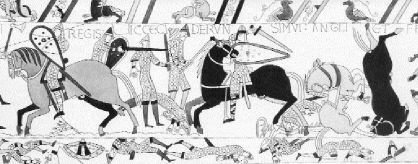
|
![[NEWS AND FACTS BANNER]](/URClipArt/misc/newsfacts.jpg) |
|||||||

Violent Knights,
"We should take care not to be blinded by the light reflected off shining armor," says Richard Kaeuper, a Rochester scholar who is uncovering the dark side of chivalry by checking out what the popular literature of the time was really saying about those gallant knights of old.
| ||||||||
| Also See: Scholars of the Rochester Round Table |
His work is also overturning some conceptions of what knights were really like. Not only were they less pious, less courtly, and less charitable to friend and foe alike than popular notions portray them, but, the historian argues, the chivalrous class was a violence-loving, fear-mongering wild card in a three-way interaction that helped create the foundations of modern Western society.
The picture that emerges is a more complex and subtle view of the Middle Ages than most people are used to.
In Kaeuper's recent book, Chivalry and Violence in Medieval Europe (Clarendon Press, Oxford, 1999), the popular misconceptions fall as quickly as a broadsword through butter. First, he points out, there was an enormous power struggle under way. As a group, the knightly class formed one leg of a societal triangle that was in direct competition for power with the other two branches: the church and the monarchy. Each faction sought to control and direct toward its own ends the pervasive violence that marked the period.
Add to that a burgeoning economic class that wanted the stability of an ordered system of rules and laws so they could conduct business, and a picture of operatic intrigue emerges.
"This is not a time of stasis, not a time of Monty Python mucking about in the darkness," Kaeuper says. (Although, for the record, he is a fan of the British comedy troupe's rendition of medieval life, noting that the comedians got many details spot-on.)
The principal misconception the author dispels is the notion of the gracious knight who faithfully serves the king and always takes time out to worship the Virgin Mother and rescue damsels in distress.
Knighthood, according to Kaeuper, meant, first and foremost, violence. Sword-swinging, limb-chopping, blood-soaked carnage--the better a knight was at the task of war, or "prowess," as it was called, the more most chroniclers swooned.
Knights were, he says, "privileged practitioners of violence," who often engaged in their own private wars to avenge a touchy sense of honor.
As he puts it in the book, in a chapter that's filled with so many accounts of noses, arms, and heads getting split off that it makes the average thrasher movie seem like an episode of The Waltons:
"We will radically misunderstand the medieval view and the medieval reality if we push the bloody, sweaty, muscular work done with lance and sword swiftly and antiseptically to the side and hasten on to speak of more abstract, more appealing qualities." To put it another way, these knights wouldn't fit in the cast of The Man from La Mancha. Or, to put it yet another way, think Darth Vader as well as Obi-Wan Kenobi.
So where did the image of knights as pious warriors--displaying those "more abstract, more appealing qualities"--come from?
The softer qualities tended to get played up, Kaeuper explains, because knights and clergy were engaged in a vigorous debate over the definition of chivalry. Clerical writers, those who most frequently invoked the pious and courtly ideal, were emphasizing what knights should be, rather than what they actually were.
It was a form of medieval spin control that attempted to influence the behavior of members of the chivalrous class, who were, by and large, avid readers of the epics and romances.
"If, in a complex world, chivalry is a force, and if its literature influences how that force is perceived, then it will be very important to put the proper spin on it," Kaeuper says. And it's those prescriptions, rather than descriptions of actuality, that have been handed down and exalted in the modern revivals of chivalry that flourished in Victorian England and the ante-bellum American South.
"It was a form of literary legislation that attempted to shape the behavior of a very powerful group of men," he says.
For their part, knights did accept some civilizing ideals, but often countered with ideals of their own, never forgetting that the world was divided into "those who work, those who pray, and those who fight."
In reality, calls for knights to be good, or pious, or kind stand out for their relative rarity in a literature drenched in blood, he points out.
For example, Kaeuper, co-editor of a 1998 edition of The Book of Chivalry written by the French knight Geoffroi de Charny, estimates that more than 75 percent of that volume--considered the handbook of knighthood--is devoted to warfare and fighting.
That's not to say knightly authors were unaware of the toll their way of life was taking on their physical wealth and well-being, not to mention their psyches and their souls.
"The knights themselves recognize what they ought to be," Kaeuper notes. "It's not as if they are walking around with their knuckles on the ground, and a few clerics are whispering, 'Shape up.' "
The epics are riddled with the appearance of "dark knights" who thunder out of sinister, dream-like forests and lay waste to everything in their path. "I think those are telling psychological images," he says.
The chivalrous class also developed a mythological family tree that showed they were, in a sense, descendants of Christ through Joseph of Arimathea. This mythology, which lay outside of church doctrine, allowed knights to claim they were serving the Lord without also having to serve the church in inconvenient ways.
The religious symbolism and prescriptions against violence have led many interpreters to argue that the code of chivalry should be seen as a corrective to savage impulses that would otherwise go unchecked.
Kaeuper disagrees.
"Chivalry is not really the solution to the question of violence," he says. "Chivalry is a code of behavior, but it is also a code of violence."
Kaeuper also disagrees with those historians who would deny that a reading of 20,000 pages of epics and romances--which is exactly what he has done over the last decade--offers valid insight into the history of the period. As he says, he is crossing the border between "historical" and "literary" evidence, and it's an approach that few others have explored. "Historians will be suspicious because this is 'imaginative literature,'" he admits. "But I think literature always reflects basic social structure."

Kaeuper: A former chemistry major who read chivalric literature in his spare time. |
Paul Hyams, a professor at Cornell University who often co-chairs a panel with Kaeuper at the annual International Congress on Medieval Studies, agrees that his approach may be unsettling both to historians and literary scholars.
"But that's the fate of anyone who works in a hyphenated field," he says. "In Britain it's called the BBC argument: If both political parties criticize you, then you must be doing something right."
Hyams says Kaeuper is clearly onto something. "If you want to recover the preconceptions of ordinary people, you can't get it from even the most voluminous sources like the church. The more promising route is to go through the entertainment literature.
"The ideas that he's canvassing are deeply ingrained in Western culture, and we ought to know why that is," Hyams says. "I don't think there's an enormous amount of this work being done."
As for Kaeuper, he is continuing his quest. During 19992000, he was the R. Stanton Avery Distinguished Fellow at the Huntington Library in San Marino, California, where he conducted research for his next installment, a study of chivalry's religious views.
The opportunity to spend a year immersed in one of the world's great research libraries is a dream come true for someone who enrolled in college as a chemistry major but read chivalric literature in his spare time.
"My avocation was always history," he says. "From the time I could read, I read things medieval." It wasn't long before he switched his major, going on to earn his Ph.D. at Princeton under Joseph Strayer, one of the pioneers in medieval European studies.
And those studies have as much resonance in the year 2000 as they did in the year 1000, Kaeuper points out.
"The issues are perennial," he says, returning to a favorite theme. "When is it acceptable to use violence? Who can use violence? What is status in a society and how do you earn it? What is love? What is the proper relationship between the genders?
"Chivalric literature proposes answers to a whole range of questions. Medieval society was a period of change, but by modern standards that change came very slowly," he says. "You can watch a whole civilization being put together, and you can see the problems and the issues they are dealing with.
"I think that always gives insight. I don't see why these stories should not be informative today just because they were written in the distant past."
That past continues to linger in the present. Although chivalry died slowly, it was eventually pushed aside as the church valorized the state above individual knights and as monarchies solidified their role as the final arbiters of power.
In time, the romantic ideal sprang up and tried to "prettify the past," Kaeuper says. He quotes a favorite author, Mark Twain, whose narrator in A Connecticut Yankee in King Arthur's Court tells readers that the glories of knighthood were so compelling that he "almost forgot to shudder."
"If we romanticize, if we 'forget to shudder,' then we lose that distinction of what's descriptive and what's prescriptive," Kaeuper says. "We lose sight of the difference between what is actually going on and what should be going on--in medieval society and in modern society."
Scott Hauser is associate editor of Rochester Review.
Maintained by University Public Relations
Please send your comments and suggestions to:
Rochester Review.
[an error occurred while processing this directive]
